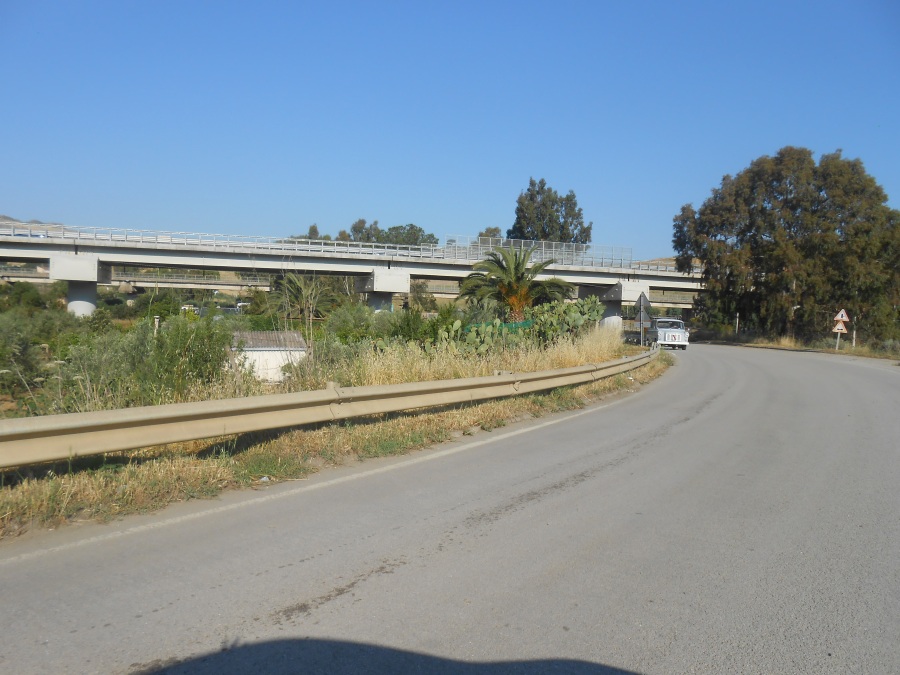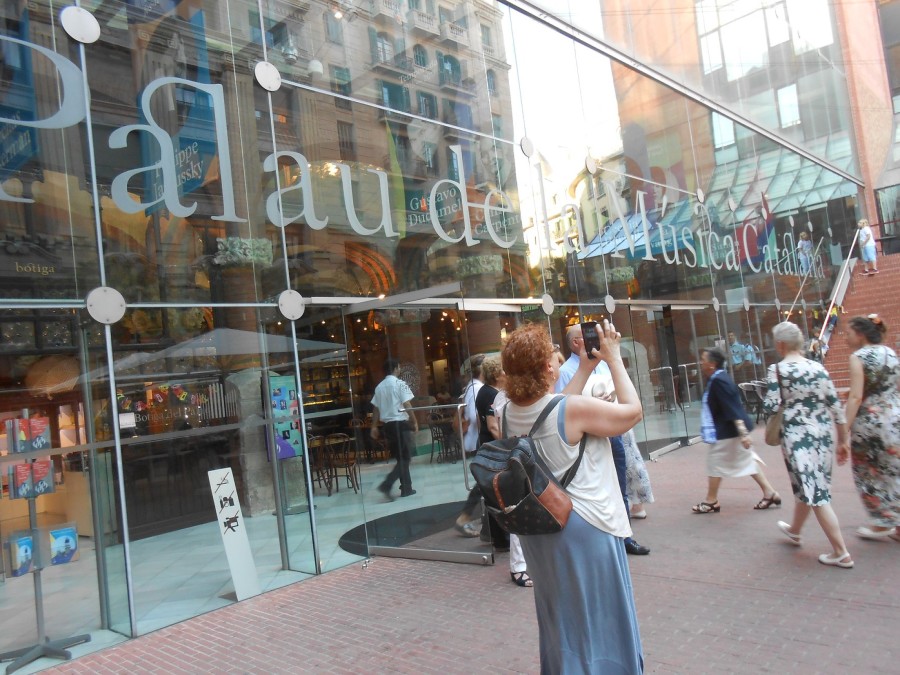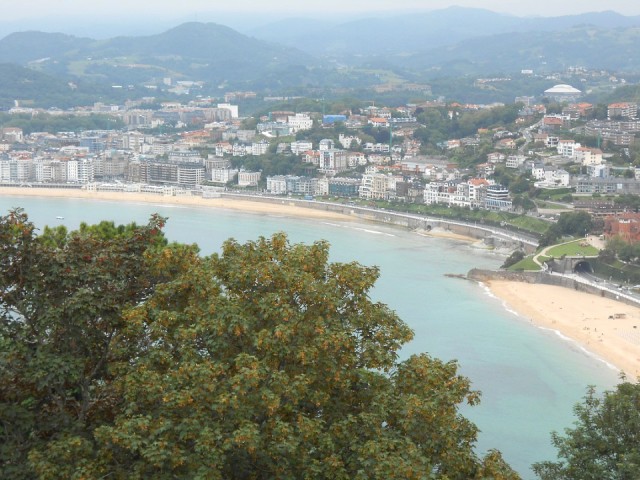
Category: travel


Keeping My Sister

They thought it would never work. We are too different, my sister and I. How could we possibly take a two-week trip together?
Rose and I are less than a year apart, so I guess it was to be expected. You can see it in our old family albums, where there’s a photo of Rose in her stroller, me standing beside it. She appears to be pushing me away.
That pretty much sums up my memory of our relationship. We are so opposite in so many ways, beginning with appearance. My father’s Teutonic ancestry is evident in her fair skin and hair. She approaches life with a self-confident stride.
I, on the other hand, manifest my mother’s dark Sicilian features. It’s immediately evident that my background is Mediterranean: Brunette hair, brown eyes, coffee complexion. And a reserved disposition.
So there we were, both in our 50s. I wanted to return to Spain, a country I’d travelled in as a recent college graduate. But I didn’t want to go alone. So I asked this most unlikely of travel companions if she wanted to go with me.
Why? Because in that circumstance, I valued the very traits that also intimidated me. My sister would stride confidently through Spain, unintimidated by language or strange cities or the fact that this would be her first trip to Europe. Or so I thought.
I’m also a teacher by nature, although not by profession. Since I was 16 and first studied Spanish, I’ve loved the language as inexplicably as most teenagers love their first love. That led to a Spanish major and the month-long solitary trek around Spain. It also led to two unforgettable years as a high school Spanish teacher.
And Rose was interested. She let me take the lead in planning the trip – half the fun, as I told her. We had minor disagreements at that stage, but no deal -breakers.
So we touched down in Madrid’s Barajas airport – and most of what I knew about it now came more from Rick Steves than my previous experience. We took a fee-controlled taxi to our hotel, a serviceable one with friendly staff, and within walking distance of the Plaza Mayor.
At this stage. I was the interpreter. Rose had questions; I posed them to the cab driver, then translated his answers. But only for the first two or three days. My sister’s fearlessness came to the fore. She started saying things herself, starting with “Do you speak English?” If the answer was no, she uses a combination of the Spanish she knew with my filling in the blanks to find out what she wanted to know.
We’ve both matured, my sister and I. There were many points at which, in the past, disagreement would have led to an argument and discord. But she gave way sometimes, and so did I. I’m fascinated with the Basques, and I wanted to visit a Basque museum. Rather than say she didn’t want to go, she said, she’d just sit and read in the lobby while I satisfied my curiosity. And she did it, not grumpily and grudgingly, as some such compromises are made, but apparently content for me to pursue my interest while she pursued hers.
I enjoyed that trip with my sister. I know she has plans to go back to San Sebastian, her favorite city there, so I think she also enjoyed the trip, although I know now that she would have planned it differently. I’m glad I was able to introduce her to Europe.
Every once in a while, I get a text from Rose, often a question about Spanish grammar or how to say something. Sometimes she writes in Spanish. I’m glad to share the language and culture I love with the sister I’ve learned to appreciate not because we are alike, but because we are so different.

Camino
It started out with all the promise of an early summer day. The sun was bright and already warm. It would be hot, but this was San Sebastian, Spain, on the Bay of Biscay. The breezes off the water would moderate the heat.
Today we would walk a short piece of the Camino de Santiago, the Way of St. James, legendary since the ninth century. It can be walked in a month, they say.
You walk the Camino, not hike it as you hike the Apppalachian Trail. The purpose is different. It’s a physical challenge, yes, but more than that, it’s a spiritual challenge. You walk the Camino because you want some something from it, something intangible, something you might not even be able to name. It’s a different “something” for each of those centuries of pilgrims who has trudged kilometer after weary kilometer.
About six of those kilometers stretched ahead of me. Loomed would be a better word. I’m not an athletic person. I knew this would be a challenge. I had no idea how much of a challenge.
It started out easy enough – about 10 minutes of easy! Then an ascent. It was a paved ascent, past a couple of new urban farms. The horse, the goats and their kids were a distraction from the rapid increase in altitude.
And it kept going up…and up! I was breathing rapidly. It wasn’t the kind of rapid breathing you get when you’re running. It seemed harsher, more forced.
The path would level out, the guide promised. Words he repeated often during the several hours I wrestled with the Camino.
The path did level out…for a few minutes. Then it ascended again. The Camino was speaking…harshly. The large stones that paved the way were round and hard under my feet. Some were just damp enough to make them slippery. And they’d go up. Not always sharply up, but you had to pay attention.
Trees shaded the Way, their roots reaching out to trip up the unwary walker. Watch the rocks! Watch the roots! I learned to plan each step carefully.
Shades of green enveloped us. Birds called. A long fat slug meandered in harm’s way until carefully removed to the side. The only other animals around besides us were the birds, which I heard rather than saw.
There was plenty to see, however. Periodically, a space in the trees opened onto a view of the bay, where blues ranged from deep to pale, white foaming where the water crashed on the rocks. Gulls circled and called.
At first, I stopped to take pictures of these photo-worthy views. Soon, though, I decided to save my attention and energy for the next step.
There were obstacles to that looming “next step.” A tree root would reach out to trip me. I quickly decided that dignity was over-rated when the safest way forward seemed to be to sit down and scoot. And shyness wasn’t even a thought when the only security was found in grabbing the guide’s hand.
But what were the options? Going back? The thought crossed my mind. I’m sure it’s been done before, especially in modern times, when human and animal feet aren’t the only means of transportation. But I had no concept of how far we were from Pasaia San Pedro, our destination. And going back would have meant struggling along the same rocky, rooted ground we’d already covered. Abandoning the Camino didn’t seem any easier than going forward.
The only way was ahead: clambering, scooting, hanging onto the guide. I learned that it didn’t pay to look further than the next step. I’d see an ascent or a descent, and it would be all I could do to keep from crying. The only way was forward. And the way forward was to think no further than the next step.
There was a fountain ahead, the guide said. To the fountain! Just make it to the fountain! How far ahead was the fountain? Like a child on a road trip, I asked, “How much further?” Just ahead. Just ahead.
Finally – the fountain! The rush of cold water over head and face. Gulps of it into a parched mouth. No thought of appearance; just blessed refreshment! The fountain was one of the delights of the walk, the water evaporating on my skin bringing respite. It was only a momentary reprieve. Thirst returned. Descents and ascents. Roots and rocks.
It would end – eventually. Taking one step at a time forward, it would end. That was the only consolation. It would end in at the village, Pasaia San Pedro. Five minutes, the guide kept saying.
My sister and I laughed about it later. It was always just five minutes to the next brief reprieve. Five minutes for him and those who, like him, knew the Camino and took to it like mountain goats!
Finally, the bar! Water, wine or beer to go with the pinxos? Water! Blessed water! Water and the pinxo of tuna and pepper or anchovy; I don’t even remember now. What mattered was that we had finished. And there was water.
It’s tempting to make a metaphor of the Camino, to say there are life lessons to be learned from the process of the walk. That is so for some. For me, that approach would make the Camino less than what it is, as if it needed my motivations, my hopes to make it worthy of being. For me, the Camino is itself. It doesn’t need me, or any other walker, to give it meaning. It is worthy in itself, for itself.
Leave it alone in its rocky, rooted, breath-taking harshness/beauty.

This Is Not New York!
Gran Via in Madrid is an elegant avenue. There is no jarring steel-and-glass starkness to introduce a sour note into that elegance. The heavy traffic – the traffic of any contemporary city – contrasts with that timeless elegance.
At one end of Gran Via is El Parque del Buen Retiro, an expansive green oasis that leads you to forget you’re in the middle of a metropolis. Tree-lined walkways, punctuated by fountains and sculptures, invite ambling. The park is populated, but the pace and purpose are peaceful.
It’s tempting to say, “Madrid is like New York City, and El Parque del Buen Retiro is like Central Park.” It seems harmless to say that. Such a statement gives the listener a sense of what Madrid and its park feel like. It’s a point of comparison that makes what is foreign seem familiar.
But it’s a siren-song familiarity. It lures the listener into the sense that he or she understands Madrid better than he or she does. The forces that shaped that city and her park are far different from those that shaped New York City and hers.
That seemingly innocuous statement flattens all that shaped and continues to shape Spain into what she is. The pre-Roman tribes disappear. The Roman presence is no more. The historic kingdoms – Castile, León, Galicia Navarre, and the rest – are felled by a single statement. The wonderfully and terrifyingly independent País Vasco and Cataluña are no more.
And please – do not say el Pais Vasco is like Louisiana, with its Cajun French! According to ethnographers and linguists, there are no people like the Basques in all of Europe. Their language is related to no other existing language. This fiercely independent people, descended from sea-faring whale-hunters, belongs only to herself, as strong as the iron for which she was also famous. Franco, even with Nazi collusion, could not stifle that spirit, although those Fascist forces leveled Guernica and slaughtered its civilians.
Cataluña too resists all attempts to meld it into an amorphous “Spanish culture.” Street signs and plaques in Catalán are just an indication of the rich history the language symbolizes. Anecdotal report indicates that her people consider themselves more French than Spanish. History and culture here go far beyond Barcelona and Gaudí.
The whole sweep of Spanish history is emasculated when we compare Spanish cities and cultural artifacts with our own, implying that our own are the norm. The Muslim conquest. The Muslim contributions in art, architecture, medicine. The graceful swirls of vines and flowers on palace walls, with not a trace of the human form. The verdant Generalife gardens. The mosques with their pillars, leading the spirit to transcend time and space. Those who conquered much of the Iberian penninsula in the name of Allah disappear in a swirl of dust.
The visitor to Spain sees only hints and traces of these varied histories and cultures. “Western” fashion, traffic, business – even the disappearance of the once-sacred siesta – can give the illusion that Madrid is not so different, after all, from Rome or Paris or New York. Even their different languages have a common base in Latin.
But do not be deceived! Spain – and Italy and France – those countries that may seem most accessible to North Americans – are not just expressions of a common contemporary culture with a different language. The forces of history and culture that shaped these and all other peoples of the world still seethe beneath the siren song of apparent similarity.
If we overlook them, it is to our peril – and our tragic loss.

The Fallen Angel
What this figure represents is tragic beyond description. All was his. Beauty. Power. Glory.
Yet it wasn’t his. It was reflected Beauty. Reflected Power. Reflected Glory. Reflected from the Source of All Good.
He couldn’t bear that. To be “only” a reflection. To be subservient in any way, even if it was subservient only to God.
You can see it all in the figure, cowering yet somehow still bearing that Glorious Reflection. That’s what makes it so tragic: that the glory, the beauty, the power still remain, but in a twisted, cowering parody of what once was.
This sculpture, entitled “El Ángel Caído,” found in Madrid’s Parque del Buen Retiro, is arresting. It is a jarring vestige of hell in this Eden.
